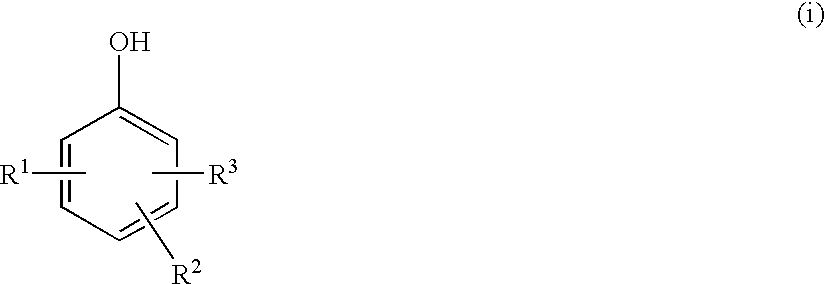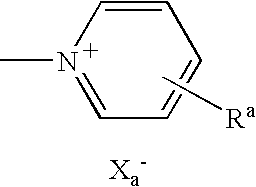Infrared-sensitvive planographic printing plate precursor
a technology of infrared-sensitive planographic printing plate and precursor, which is applied in the direction of lithography, photosensitive materials, instruments, etc., can solve the problems of missing portions, defects on the recording surface, and insufficient mechanical strength of the recording layer
Inactive Publication Date: 2007-03-29
FUJIFILM HLDG CORP +1
View PDF7 Cites 1 Cited by
- Summary
- Abstract
- Description
- Claims
- Application Information
AI Technical Summary
Benefits of technology
[0048] The organic polymer layer in the invention may contain only the particular thermosetting resin as a polymer component. However, as far as effects of the invention are not impaired, organic polymers other than the particular thermosetting resins such as polystyrene, polyamide, polyurethane, polyurea, an acrylic resin and a polyvinyl acetal resin can be used together. The organic polymers that can be used together are preferably hydrophobic resins from a viewpoint of effects.
[0049] The content of other organic polymers that can be used together is preferably 40% by mass or less with respect to the particular thermosetting resins. (Other Components)
[0050] For the purpose of imparting flexibility, adjusting slidability and improving a coating surface state, plasticizers, surfactants and other additives may be added to an organic polymer layer in such an amount that the effect of the invention is not deteriorated. (Plasticizer)
[0051] As the plasticizer, for example, phthalic acid esters such as dimethyl phthalate, diethyl phthalate, dibutyl phthalate, diisobutyl phthalate, dioctyl phthalate, octylcapryl phthalate, dicyclohexyl phthalate, ditridecyl phthalate, butylbenzyl phthalate, diisodecyl phthalate, and diallyl phthalate, glycol esters such as dimethylglycol phthalate, ethylphthalylethyl glycolate, methylphthalylethyl glycolate, butylphthalylbutyl glycolate, and triethylene glycol dicaprylic acid ester, phosphate esters such as tricresyl phosphate, and triphenyl phosphate, aliphatic dibasic acid esters such as diisobutyl adipate, dioctyl adipate, dimethyl sebacate, dibutyl sebacate, dioctyl azelate, and dibutyl maleate, polyglycidyl methacrylate, triethyl citrate, glycerin triacetyl ester, and butyl laurate are effective.
[0052] The addition amount of the plasticizer varies depending on the kind of an organic polymer used in an organic polymer layer, and it is preferable that the plasticizer is added in such an amount that a glass transition temperature of the layer is not 60° C. or lower. (Surfactant)
[0053] Examples of the surfactant include anionic, cationic, nonionic and amphoteric surfactants. Specific examples include nonionic surfactants such as polyoxyethylene alkyl ethers, polyoxyethylene alkyl phenyl ethers, polyoxyethylene polystyryl phenyl ethers, polyoxyethylene polyoxypropylene alkyl ethers, glycerin fatty acid partial esters, sorbitan fatty acid partial esters, pentaerythritol fatty acid partial esters, propylene glycol monofatty acid esters, sucrose fatty acid partial esters, polyoxyethylene sorbitan fatty acid partial esters, polyoxyethylene sorbitol fatty acid partial esters, polyethylene glycol fatty acid esters, polyglycerin fatty acid partial esters, polyoxyethylenated castor oils, polyoxyethyleneglycerin fatty acid partial esters, fatty acid diethanolamides, N,N-bis-2-hydroxyalkylamines, polyoxyethylenealkylamine, triethanolamine fatty acid ester, and trialkylamine oxide, anionic surfactants such as fatty acid salts, abietic acid salts, hydroxyalkanesulfonic acid salts, alkanesulfonic acid salts, dialkylsulfosuccinic acid ester salts, straight chain alkylbenzenesulfonic acid salts, branched alkylbenzenesulfonic acid salts, alkylnaphthalenesulfonic acid salts, alkylphenoxypolyoxyethylenepropylsulfonic acid salts, polyoxyethylene alkyl sulfophenyl ether salts, N-methyl N-oleyltaurine sodium salt, N-alkylsulfosuccinic acid monoamide disodium salt, petroleum sulfonic acid salts, sulfated beef tallow oil, sulfate ester salts of fatty acid alkyl ester, alkyl sulfate ester salts, polyoxyethylene alkyl ether sulfate ester salts, fatty acid monoglyceride sulfate ester salts, polyoxyethylene alkyl phenyl ether sulfate ester salts, polyoxyethylene styryl phenyl ether sulfate ester salts, alkylphosphate ester salts, polyoxyethylene alkyl ether phosphate ester salts, polyoxyethylene alkyl phenyl ether phosphate ester salts, partial saponified products of styrene / maleic anhydride copolymer, partial saponified products of olefin / maleic anhydride copolymer, and naphthalenesulfonic acid salt formalin condensates, cationic surfactants such as alkylamine salts, quaternary ammonium salts, polyoxyethylenealkylamine salts, and polyethylenepolyamine derivative, and amphoteric surfactants such as carboxylbetaines, aminocarboxylic acids, sulfobetaines, aminosulfate esters, and imidazolines. Among the above-listed surfactants, polyoxyethylene can be also read as polyoxyalkylene such as polyoxymethylene, polyoxypropylene and polyoxybutylene, and those surfactants are also included.
Problems solved by technology
However, in this positive-type planographic printing plate precursor, mechanical strength of the recording layer is not sufficient.
As a result, when the recording surface thereof and other members are strongly contacted at the time of manufacturing, transportation or handling, defects are generated on the recording surface, whereby missing portions are generated in the image area after development.
However, since interleaving sheets have the problems of 1) increase in cost, and 2) disposal of the interleaving sheets, an “interleaving sheet-less” process using no interleaving sheets is desired.
However, in the case where an inorganic pigment such as silica gel is contained in a back coating layer, it is found that, when products which have been stacked and packaged without using interleaving sheets are transported, since the hardness of the inorganic pigment is high, abrasion to a photosensitive layer due to rubbing is easily caused.
When previously disclosed organic polymers are used, there are problems in that the organic polymers are dissolved in the cleaning agent, whereby the organic polymers become sticky, thus deteriorating the workability, and adherence of the polymers to the recording layer can easily occur.
For instance, among the resins, PET (polyethylene terephthalate resin) can be dissolved only in special and expensive organic solvents, hence, while PET can avoid such a stickiness problem, it is inappropriate for industrial manufacturing.
However, the respective polymers, being thermoplastic resins, melt during the process and thereby cause problems of contamination of burning processor rolls.
Furthermore, with respect to photosensitive planographic printing plates (precursors) having a back coating layer including an organic polymer such as polyester, it has been found that, when an autoloader for automatically feeding printing plates to a laser exposure apparatus is used without interleaving sheets, abrasion is easily caused of the photosensitive layer due to rubbing, when the autoloader has a structure in which the photosensitive layer and the back surface are pressed against each other.
Method used
the structure of the environmentally friendly knitted fabric provided by the present invention; figure 2 Flow chart of the yarn wrapping machine for environmentally friendly knitted fabrics and storage devices; image 3 Is the parameter map of the yarn covering machine
View moreImage
Smart Image Click on the blue labels to locate them in the text.
Smart ImageViewing Examples
Examples
Experimental program
Comparison scheme
Effect test
examples
[0202] The invention will be described in detail below by way of Examples, but the invention is not limited to them.
the structure of the environmentally friendly knitted fabric provided by the present invention; figure 2 Flow chart of the yarn wrapping machine for environmentally friendly knitted fabrics and storage devices; image 3 Is the parameter map of the yarn covering machine
Login to View More PUM
 Login to View More
Login to View More Abstract
According to an aspect of the invention, there is provided an infrared-sensitive planographic printing plate precursor including: a support; a recording layer on one surface of the support, which recording layer contains a water-insoluble and alkali-soluble resin and an infrared absorber, and is capable of forming an image by infrared irradiation; and an organic polymer layer on the other surface of the support, which organic polymer layer is formed by coating and drying a solution that contains at least one organic polymer selected from epoxy resins and resole resins, and a crosslinking agent.
Description
CROSS-REFERENCE TO RELATED APPLICATION [0001] This application claims priority under 35 USC 119 from Japanese Patent Application No. 2005-278800, the disclosure of which is incorporated by reference herein. BACKGROUND OF THE INVENTION [0002] 1. Field of the Invention [0003] The present invention relates to an infrared-sensitive planographic printing plate precursor. In particular, the invention relates to an infrared-sensitive planographic printing plate precursor which is excellent in abrasion resistance. [0004] 2. Description of the Related Art [0005] Laser technology has been highly developed in recent years, and in particular, with respect to solid lasers and semiconductor lasers which have a light emitting region from near infrared to infrared, high output and small size lasers are readily available. In particular, in the field of planographic printing, as a light source for exposure when a printing plate is made directly from digital data of computers, these lasers are very us...
Claims
the structure of the environmentally friendly knitted fabric provided by the present invention; figure 2 Flow chart of the yarn wrapping machine for environmentally friendly knitted fabrics and storage devices; image 3 Is the parameter map of the yarn covering machine
Login to View More Application Information
Patent Timeline
 Login to View More
Login to View More IPC IPC(8): G03C1/00
CPCB41C1/1016B41C2201/04B41C2201/14B41C2210/02B41C2210/26B41C2210/14B41C2210/22B41C2210/24B41C2210/06
Inventor NAGASHIMA, AKIRA
Owner FUJIFILM HLDG CORP
Features
- R&D
- Intellectual Property
- Life Sciences
- Materials
- Tech Scout
Why Patsnap Eureka
- Unparalleled Data Quality
- Higher Quality Content
- 60% Fewer Hallucinations
Social media
Patsnap Eureka Blog
Learn More Browse by: Latest US Patents, China's latest patents, Technical Efficacy Thesaurus, Application Domain, Technology Topic, Popular Technical Reports.
© 2025 PatSnap. All rights reserved.Legal|Privacy policy|Modern Slavery Act Transparency Statement|Sitemap|About US| Contact US: help@patsnap.com



